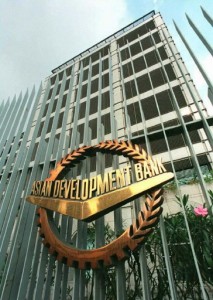MANILA, Philippines–The Asian Development Bank (ADB) has reduced its growth forecasts for the Philippines for this year and the next, citing slower government spending and the rise in the prices of basic goods.
The Manila-based multilateral lender also warned that the economic renaissance being enjoyed by the country would not be sustained in the long term if the country’s next president were to discontinue the reforms introduced and implemented by the Aquino administration.
In its updated Asian Development Outlook 2014 report released Thursday, the ADB said that the Philippines’ gross domestic product (GDP) could expand by 6.2 percent this year—lower than the previous forecast of 6.4 percent.
For 2015, Philippine GDP would likely rise 6.4 percent, ADB said.
When it came out with its 2015 forecast last April, ADB said the economy would expand by 6.7 percent.
“The slightly lower growth is due largely to a slowdown in government spending, which grew 0.9 percent in the first half of 2014, compared to 11.1 percent in the same period last year. The slowdown came off a high point in 2013, election year, but also reflects caution among government agencies amid concerns about the misuse of public funds,” the ADB said in a statement.
In a press conference, ADB country director for the Philippines Richard S. Bolt said congestion at Manila’s ports, aggravated by the truck ban implemented by the city government from February to early this month, was among the reasons behind the expected slower growth.
Despite lower forecasts, ADB said the Philippines’ growth would still be robust compared with most of its neighbors.
“Consumption and investments remain strong, and exports are recovering,” Bolt noted.
To sustain economic gains, as well as spur more employment, Bolt said the government should accelerate infrastructure investment, put in place measures to strengthen competition, and make financing increasingly accessible.
As for inflation, the ADB raised its forecasts to 4.4 percent this year (from 4.3 percent previously) and 4.1 percent next year (from 4 percent previously).
The higher inflation projections came on the back of pending petitions to jack up costs of utilities, as well as the expected dry weather that could impact on food production by yearend.
The ADB nonetheless expects the Philippines’ exports to rebound as global markets recover, while it attracts more of the brick-and-mortar and job-creating foreign direct investment (FDI).
“We expect more inflows of FDI into the Philippines, although still lower than its neighbors in the region,” Bolt said.
For Joven Z. Balbosa, senior country specialist for the Philippines at the ADB, liberalization of the restrictions enshrined in the Constitution will help attract more foreign investors, and must “be encouraged.”
But Bolt warned that the gains being made by the present government would be in vain if the new leaders who would assume office in 2016 were to interrupt the current reform agenda.
In particular, the rollout of much-needed infrastructure projects under the public-private partnership (PPP) program should be sustained, Bolt said.
“We hope infrastructure development will continue in the next administration,” he said.
Originally posted at 03:01 pm | Thursday, September 25, 2014
RELATED STORIES
ADB cuts Asean growth forecast
ADB raises growth forecast for PH
